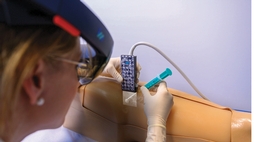Augmented reality (AR) helps reduce the time needed for ultrasound (US)-guided needle placements and closes the gap in performance between inexperienced operators and their more experienced counterparts, according to research presented Tuesday.

Farshad-Amacker
AR involves the superimposition of a computer-generated image over the user's view of the real world. For US applications, the operator wears an AR headset that displays the live US image superimposed on the patient at the point of interest. This technology, known as AR in situ, or in place, can help guide procedures like needle placements.
"While scanning with the AR in situ ultrasound, the displayed, superimposed image is updated in real-time as the operator moves the transducer, displaying the anatomical structures at their correct anatomical location in a 1:1 scale," said study first author Nadja A. Farshad-Amacker, MD, of Balgrist University Hospital Zurich, Switzerland.
"In addition, a larger-sized image of the ultrasound can be displayed, for example, above the patient," Dr. Farshad-Amacker said.
In the study, Dr. Farshad-Amacker and colleagues compared US-guided needle placement with and without AR in situ US, independent of the expertise of the operator. Researchers performed the needle placement on medical imaging phantoms, objects used as stand-ins for human tissues.
AR Aids Untrained Operators
Three untrained operators and two experienced radiologists performed 200 US-guided punctures: 100 with and 100 without AR in situ US. The punctures were performed on a leg phantom with soft tissue lesions and a blood vessel phantom.
AR in situ US reduced the mean time to puncture from 30 seconds to 22 seconds. It also reduced the number of needle passes compared to the conventional US technique. The initial gap in the performance of untrained operators vs. experienced radiologists with the conventional method narrowed with the use of the AR system. Inexperienced operators reduced both their average time to puncture and number of needle passes.
"AR in situ ultrasound seems to simplify the operator's spatial orientation, reducing experience-based differences in performance of ultrasound-guided interventions," Dr. Farshad-Amacker said.
The technology could benefit patients by providing increased accuracy and speed for US-guided interventions. Increased accuracy would also benefit operators, Dr. Farshad-Amacker said.

An AR-guided puncture on a leg phantom. Image courtesy of Nadja A. Farshad-Amacker, MD
"Using AR in situ ultrasound, operators could be faster and more precise for ultrasound-guided interventions, since the operator can directly aim the needle toward the in situ image of a lesion," she said.
Future advancements of AR in situ US include guidance applications for punctures using trajectory holograms. Also, more mobile systems with cable-free US probes are being developed and will simplify procedures that require sterile conditions.
"This is a proof-of-concept study documenting the potential merits of a novel technology that could be a breakthrough in ultrasound applications," Dr. Farshad-Amacker said. "Clinical studies are needed and planned to illuminate the potential merits of this new technology in vivo."
Related links:

